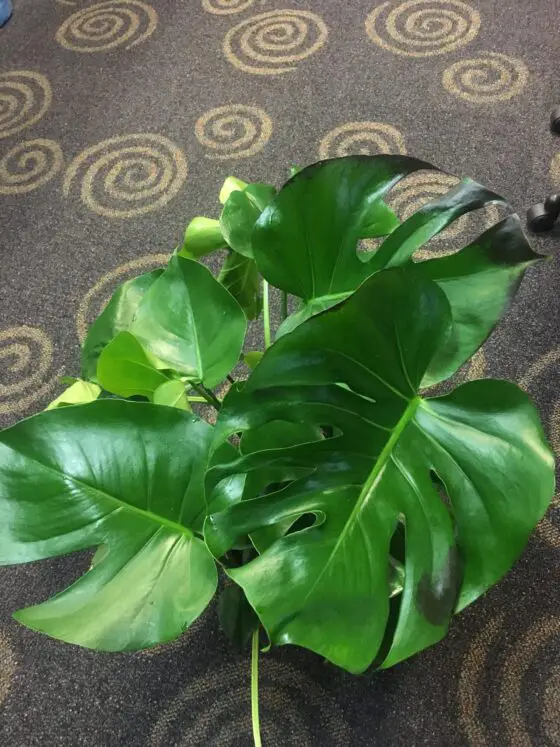Are you wondering how cold can monstera tolerate? Well, you’re in the right place! Monstera plants, with their iconic split leaves and tropical allure, have gained popularity among plant enthusiasts around the world. However, their sensitivity to temperature fluctuations often leaves growers puzzled.
In this article, we will explore the ideal temperature range for monstera plants and provide practical tips to help you keep your beloved tropical beauty thriving. So, let’s dive in and uncover the secrets of maintaining the perfect climate for your monstera.
How Cold Can Monstera Tolerate: A Comprehensive Guide
Monstera plants, with their large, glossy leaves and iconic split patterns, have become a popular choice for indoor and tropical gardens. These tropical plants are known for their ability to thrive in warm and humid environments, but how well can they tolerate cold temperatures?
In this guide, we will explore the temperature preferences of Monstera plants and provide tips on how to care for them during colder seasons.
Understanding Monstera Plant Hardiness
Before we delve into the specifics of cold tolerance, it’s important to understand plant hardiness zones. The United States Department of Agriculture (USDA) developed a map that divides the country into zones based on the average minimum temperatures experienced in each region.
This information can help gardeners determine which plants are likely to survive in their climate.
Monstera plants are native to the tropical regions of Central and South America, where temperatures remain consistently warm throughout the year. As such, they are typically classified as suitable for hardiness zones 10-12, which experience milder winters with minimal frost.
However, this classification doesn’t mean that Monstera plants cannot survive in colder zones. With proper care and protection, they can withstand lower temperatures to a certain extent.
Ideal Temperature Range for Monstera Plants
While Monstera plants prefer warmer climates, they do have a range of temperatures in which they thrive. The ideal temperature range for these plants is between 65°F (18°C) and 85°F (29°C).
Within this range, Monstera plants exhibit vigorous growth and maintain the healthiest foliage.
The Impact of Cold Temperatures on Monstera Plants
Exposure to cold temperatures outside of their preferred range can have adverse effects on Monstera plants. Some common impacts include:
- Stunted growth:
Cold temperatures can slow down the growth of Monstera plants, leading to smaller leaves and diminished overall size.
- Leaf damage:
Freezing temperatures can cause the water within the plant cells to expand, resulting in cellular damage. This damage often manifests as wilted, brown, or blackened leaves.
- Root damage:
Cold soils can negatively affect the root system of Monstera plants, hindering nutrient absorption and overall plant health.
- Death:
Prolonged exposure to extremely cold temperatures can ultimately lead to the death of Monstera plants.
Read More: About How Often To Water Terrarium
Protecting Monstera Plants from Cold Temperatures
While Monstera plants may not be as cold-tolerant as some other houseplants, there are several measures you can take to protect them during colder seasons.
These tips will help ensure the health and survival of your Monstera plant:
1. Adjust watering practices:
During colder periods, Monstera plants go through a natural slowdown in growth. Adjusting your watering schedule accordingly is crucial. Rather than watering on a rigid schedule, monitor the soil’s moisture level and water only when the top inch (2.5 cm) feels dry to the touch.
Overwatering during winter dormancy can lead to root rot.
2. Provide adequate humidity:
Monstera plants prefer high humidity levels, even during colder months. To mimic their natural environment, use a humidifier, place a tray with water near the plant, or mist the leaves regularly. This extra humidity will help prevent leaf dryness and damage.
3. Shield from cold drafts:
Avoid placing your Monstera plant near drafty windows, doors, or vents. Cold drafts can significantly lower the temperature around the plant and cause stress. Find a location that provides consistent warmth, away from any sources of cold air.
4. Use temperature control devices:
In areas with consistently cold temperatures, you can consider using heating mats or grow lights to provide additional warmth to your Monstera plant. These devices can help maintain the desired temperature range and promote healthy growth.
5. Move plants indoors:
If your Monstera plant is in a pot or container, consider moving it indoors during the colder months. Choose a well-lit area, away from cold drafts, and where the temperature remains within the acceptable range. If you decide to keep your Monstera plant indoors permanently, ensure it receives adequate light for photosynthesis.
6. Cover outdoor plants:
For Monstera plants growing outdoors, covering them with a frost blanket or cloth during cold nights can provide protection against freezing temperatures. Be sure to remove the cover during the day to allow airflow and prevent excessive condensation.
7. Monitor temperature fluctuations:
Keep an eye on weather forecasts and be prepared to take action if temperatures drop unexpectedly. Move your Monstera plants to a more protected location or implement additional insulation measures, such as adding mulch around the base of the plant to regulate soil temperature.
The Frost Tolerance of Monstera Deliciosa
Monstera deliciosa, also known as the Swiss cheese plant, is one of the most common varieties. It is a climber and can grow to impressive heights indoors or in tropical outdoor settings. While it shares similar preferences to other Monstera varieties, it also exhibits a greater tolerance for cooler temperatures and light frosts.
Monstera deliciosa can generally handle temperatures as low as 50°F (10°C) without suffering significant damage. However, extended exposure to cold temperatures or frost can still harm the plant. It’s always best to err on the side of caution and protect your Monstera deliciosa during colder months.
Protecting Monstera Deliciosa from Frost
To safeguard your Monstera deliciosa from frost, consider the following measures:
- Move potted plants indoors or to a sheltered location when frost is expected.
- Cover plants with a frost blanket or cloth during cold nights.
- Apply a layer of mulch around the base of the plant to insulate the roots.
- Consider using an outdoor heating source, such as a heat lamp, to provide extra warmth during extreme cold spells.
Understanding the cold tolerance of Monstera plants is crucial for their care and survival. While they prefer warm and tropical conditions, with proper precautions and adjustments, Monstera plants can withstand colder temperatures. By implementing the tips and strategies outlined in this guide, you can help your Monstera thrive throughout the year, even in less-than-ideal conditions.
Remember to monitor temperature fluctuations, protect against frost, and adjust watering and humidity levels to ensure the health and longevity of your Monstera plants.
Read More: About What Bugs To Put In Terrarium?
Frequently Asked Questions (FAQs)
Monstera plants can tolerate temperatures between 65°F (18°C) and 85°F (29°C). They are tropical plants and do not tolerate extreme cold or frost.
No, Monstera plants cannot survive freezing temperatures. Exposure to frost can cause significant damage to the plant, including leaf discoloration, wilting, and even death.
If your Monstera has been exposed to cold temperatures, it is important to assess the damage. Remove any damaged or discolored leaves and provide optimal growing conditions, including warmth and humidity, to aid in its recovery.
No, it is not advisable to keep Monstera plants outdoors during winter, especially in regions with cold temperatures. It is best to bring them indoors to protect them from the cold.
The ideal temperature range for Monstera plants is between 70°F (21°C) and 75°F (24°C). Maintaining temperatures within this range helps promote healthy growth and prevents stress to the plant.
Monstera plants can tolerate air conditioning or central heating to some extent, but it is important to avoid exposing them to excessive cold or hot air. Proper humidity levels should also be maintained to prevent drying of the leaves.
Monstera plants are sensitive to cold drafts, and a consistently cold and drafty room can negatively impact their health. It is best to avoid placing them in such environments and instead choose a more stable and warm location.
To protect your Monstera from cold temperatures, you can use various methods such as moving it to a warmer location, providing insulation around the pot, using a plant heater or heat mat, or covering it with a plant blanket during cold spells.
Final Thoughts
Monstera plants can tolerate moderately cold temperatures, but they are generally not frost-tolerant. It is best to keep them in a temperature range of 65-85°F (18-29°C), as they thrive in warm and humid conditions. Monstera can suffer from cold stress if exposed to temperatures below 50°F (10°C) for extended periods. Protecting them from cold drafts and sudden temperature drops is crucial to their well-being.
Although monstera can handle cooler temperatures temporarily, it is advisable to keep them in a warm and controlled environment to maintain their optimal growth and health. So, how cold can monstera tolerate? While they can withstand a bit of chilliness, it’s best to keep them warm to ensure their thriving.
Auto Amazon Links: No products found.
Perfect Plants Christmas Tree Saver 8oz. | Easy Use Xmas Tree Preserver Food | Have Healthy Green Christmas Trees All Holiday Season
$7.99 (as of December 26, 2025 06:42 GMT +00:00 - More info- Product prices and availability are accurate as of the date/time indicated and are subject to change. Any price and availability information displayed on [relevant Amazon Site(s), as applicable] at the time of purchase will apply to the purchase of this product.
FirEver Pure Christmas Tree Food | Preserver Additive & Season Extender for Live Xmas Trees | Keep It Green, Reduce Needle-Drop | Miracle Freshness (8 oz)
$9.16 (as of December 26, 2025 06:42 GMT +00:00 - More info- Product prices and availability are accurate as of the date/time indicated and are subject to change. Any price and availability information displayed on [relevant Amazon Site(s), as applicable] at the time of purchase will apply to the purchase of this product.
Wilt-Pruf® Christmas Tree/Cutting Preserver Spray |Preserves Christmas Trees, Wreaths, Garlands, Cuttings and Carved Pumpkins | Reduces Needle Drop | Keeps Cut Trees Fresh Longer | Natural (32 oz)
$21.99 (as of December 26, 2025 06:42 GMT +00:00 - More info- Product prices and availability are accurate as of the date/time indicated and are subject to change. Any price and availability information displayed on [relevant Amazon Site(s), as applicable] at the time of purchase will apply to the purchase of this product.
Transmission Funnel - 3'' Wide 23'' Long Funnel with Hose – Flexible, Reusable, No Leak Design Featuring Elastic Long Hose | Long Funnel for Oil, Gas, Coolant, Automotive and Garage Applications
$7.95 (as of December 26, 2025 06:42 GMT +00:00 - More info- Product prices and availability are accurate as of the date/time indicated and are subject to change. Any price and availability information displayed on [relevant Amazon Site(s), as applicable] at the time of purchase will apply to the purchase of this product.
Rocky Mountain Goods Christmas Tree Food - 8 oz Tree Preservative - Reduce Needle Drop - Greener Scent - Fir, Pine, Spruce Trees - Extend Tree Life
$9.95 (as of December 26, 2025 06:42 GMT +00:00 - More info- Product prices and availability are accurate as of the date/time indicated and are subject to change. Any price and availability information displayed on [relevant Amazon Site(s), as applicable] at the time of purchase will apply to the purchase of this product.
Muddy Mat® | Super Absorbent Door Mat Indoor, Microfiber Quick Dry Chenille Entryway Rug, Non-Slip Front Door Mat, Indoor Mats for Entryway, Machine Washable Pet Rug, Grey 30"x19"
$24.95 (as of December 25, 2025 12:41 GMT +00:00 - More info- Product prices and availability are accurate as of the date/time indicated and are subject to change. Any price and availability information displayed on [relevant Amazon Site(s), as applicable] at the time of purchase will apply to the purchase of this product.
OLANLY Dog Door Mat for Muddy Paws 30x20, Absorbs Moisture and Dirt, Absorbent Non-Slip Washable Doormat, Quick Dry Chenille Mud Mat for Dogs, Entry Indoor Entryway Carpet for Inside Floor, Grey
$9.99 (as of December 25, 2025 12:41 GMT +00:00 - More info- Product prices and availability are accurate as of the date/time indicated and are subject to change. Any price and availability information displayed on [relevant Amazon Site(s), as applicable] at the time of purchase will apply to the purchase of this product.
Zevo Flying Insect Trap Official Refill Cartridges - Fits Both Zevo Trap & MAX Indoor Fly Trap - Authentic Trap+Lock Technology to Catch Gnats, House & Fruit Flys (4 Official Refill Cartridges)
$14.97 (as of December 25, 2025 12:41 GMT +00:00 - More info- Product prices and availability are accurate as of the date/time indicated and are subject to change. Any price and availability information displayed on [relevant Amazon Site(s), as applicable] at the time of purchase will apply to the purchase of this product.
TERRO Ant Killer Bait Stations T300B - Liquid Bait to Eliminate Ants - Bait System - 12 Count Stations for Effective Indoor Ant Control
$10.88 (as of December 25, 2025 12:41 GMT +00:00 - More info- Product prices and availability are accurate as of the date/time indicated and are subject to change. Any price and availability information displayed on [relevant Amazon Site(s), as applicable] at the time of purchase will apply to the purchase of this product.
ThermoPro TP50 Digital Hygrometer Indoor Thermometer Room Thermometer and Humidity Gauge with Temperature Humidity Monitor
$11.99 (as of December 25, 2025 12:41 GMT +00:00 - More info- Product prices and availability are accurate as of the date/time indicated and are subject to change. Any price and availability information displayed on [relevant Amazon Site(s), as applicable] at the time of purchase will apply to the purchase of this product.











